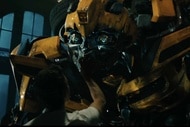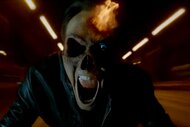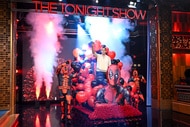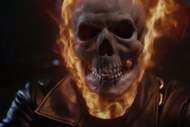Create a free profile to get unlimited access to exclusive videos, sweepstakes, and more!
The 10 best new comic books of 2019

Welcome to SYFY WIRE's Year in Review, a series of articles that will look to catalog the best, worst, and weirdest cultural and entertainment moments of 2019 as we look toward the future. Today, we celebrate the best new comic books of the year!
The fact that we ended up with more titles on our honorable mentions list than we did on our "Best Comics" should illustrate how difficult it was to pick the best new comic books of 2019. This year, there were literally thousands of comic books released from Marvel, DC, Image, Boom, Valiant, Oni Press, and Dark Horse — and that's not even counting the many smaller publishers. So, while we would have loved to read them all, there were invariably great ones we missed, so for that, we apologize.
In 2019, reexamination and reflection were major themes in some of the comic books we loved best. Whether it was a reimagining of the X-Men in House of X and Powers of X, or a look into the future of America in Undiscovered Country, or the themes of rebirth and reincarnation in Little Bird, each of these comic books struck a chord with us and expanded on the comic medium as a whole.
Before we get into the meat, though, we have to give an honorable mention to the following comics that, unfortunately, did not make our list. They are: The New World (Image), Assassin Nation (Image), Murder Falcon (Image), DCeased (DC), Captain Marvel (Marvel), The Punisher (Marvel), Crowded (Image), Blackbird (Image), Ascender (Image), DIE (Image), Once and Future (BOOM!), Immortal Hulk (Marvel), Wonder Woman (DC), Superman Smashes the Klan (DC), Female Furies (DC), King Thor (Marvel), The Wildstorm (DC), Green Lantern (DC), Something Is Killing the Children (BOOM!), Goddess Mode (Image), Spider-Man: Life Story (Marvel), Dial H for Hero (DC), The Girl in the Bay (Image), and Marauders (Marvel).
We hope you enjoy these comics as much as we did, and if we missed some, please let us know on social!
01. Daredevil (Marvel)
Writer: Chip Zdarsky, Art: Marco Chechetto, Colors: Sunny Gho, Letters: Clayton Cowles
Daredevil has a long history of being beaten down only to rise again as the hero of Hell’s Kitchen. In 2019, writer Chip Zdarsky tweaked that formula and leaned into Matt’s Murdock’s shattered life after he was run over by a car and nearly killed last year.
In an interview with SYFY WIRE, Zdarksy said his favorite kind of superhero tales are those where the hero has "lost everything" and has to build themselves up again. Taking over from previous Daredevil scribe Charles Soule, Zdarsky's take on the hero has been unique in how it examines the psychological cost, along with the physical, of being a superhero.
In the first arc, Matt is forced to look at why he still fights as Daredevil and the real-world consequences of the violence he seems to be addicted to. With cameos from the Defenders and a few other heroes, Zdarsky explores the fine line between being a reckless vigilante and being a true superhero.
Marco Chechetto's art is fluid and gorgeous and his panels feel straight out of a crime drama. His take on classic versions of Marvel characters, especially Elektra and Spider-Man, is familiar while still exciting. It also doesn’t hurt that Julian Todesco has been providing amazing covers for the comic from week to week. Daredevil is sleek, fun to read and continues to expand on Matt Murdock’s mythos 15 issues in.
02. Little Bird (Image)
Writer: Darcy Van Poelgeest, Art: Ian Bertram, Colors: Matt Hollingsworth, Letters: Aditya Bidikar
Beautiful, inspiring, and terrifying, Little Bird takes place in a post-apocalyptic, post-human world where the church has taken over the state and rules what’s left of America with a facist fist. In this new America, the New Vatican has all but stamped out a band of resistance fighters, now ready to make a last stand in northern Canada.
That’s where it gets crazy, with appearances by reincarnation genes, a plague sweeping through America, genetically modified beings, and an army of horrific clergy on a mission to purify the United Nations of America.
Written by award-winning filmmaker Darcy Van Poelgeest, Little Bird marks the writer/producer’s first foray into comic books. He’s already announced a follow-up to the book alongside the original team of artist Ian Bertram, colorist Matt Hollingsworth, and letterer Aditya Bidika. The world-building in Little Bird is massive in scale and the Moebius-like art from Bertram and Hollingsworth reflects Van Poelgeest’s grand vision.
Immersed in a techno-organic future, Little Bird stands as a stark reflection on the power of religion and hope.
03. House of X/Powers of X (Marvel)
Writer: Jonathan Hickman, Art: R.B. Silva, Pepe Larraz, Inks: R.B. Silva, Adriano Di Benedetto, Colors: Marte Gracia, Letters: Clayton Cowles, Design: Tom Muller
Maintaining his tradition of knocking major Marvel events out of the park, Jonathan Hickman returned over the summer to effectively reboot the X-Men. But, as Hickman pointed told SYFY WIRE just prior to the launch of House of X and Powers of X, the key would be in presenting “brand new ideas that feel like old ones.”
With HoX/PoX, Hickman and the artistic team of R.B. Silva, Pepe Larraz, Adriano Di Benedetto, and Marte Gracia have done just that and presented a new grand vision for the X-Men. Mutants, led by Professor X, Magneto, and the Quiet Council, have a new home on the island of Krakoa, a mutant itself. Retconning longtime X-friend Moira McTaggert as a previously undisclosed mutant, Hickman has given Marvel’s famous mutants new power sets. To put it simply, mutants can never die. With the help of "The Five" and Professor X, the X-Men are now able to be reincarnated.
In addition to all of this, Krakoa is now home to all mutants, which means heroes like Professor X, Wolverine, Cyclops, Storm, and Kitty Pryde will now be working and living with the likes of Apocalypse, Mr. Sinister, Sebastian Shaw, and Magneto.
One of the most beautiful books on the list, the series also featured the incredible design work of Tom Muller. Working alongside Hickman, the two took great care in crafting new "data pages" featuring charts, maps, and information to flesh out the ins and outs of the new world of mutants.
Additionally, HoX/PoX also pulled off the not-so-easy feat of arriving on time for 12-straight weeks, placing it as one of Marvel’s best event series ever.
04. Undiscovered Country (Image)
Writer: Charles Soule, Scott Snyder, Art: Giuseppe Camuncoli, Colors: Matt Wilson, Letters: Crank!
Upon its debut in November, Undiscovered Country topped both Batman and Amazing Spider-Man in sales. Even though this is the first joint project for longtime friends Charles Soule and Scott Snyder, it’s something they’ve been cooking up for years. After a trip to the CIA for research in 2016, the pair brainstormed an idea about America closing its doors for good.
Such was born Undiscovered Country, in which America has been sealed off from the outside world for the last 30 years. Amidst a global outbreak of disease worldwide, a small team of investigators are invited to peel back the curtain and see what has become of the former Land of the Free.
In an age where the sitting American president has been pushing to wall off the country, Snyder and Soule’s idea of an America lost to the ages is perfectly timed. According to both writers, the story was born after seeing glimpses of the future defense technology on a tour of the CIA. They also credited the rising tensions between nationalism and socialism in the country and abroad for inspiring their tale.
Complete with a timeline of events leading up to the sealing and blurbs from fictional documents, Soule and Snyder present a dark vision of the future of America. In the first issue alone, we’re treated to Camuncoli’s visions of crazed marauders riding giant mutated prawns, sea snakes, and sharks in the barren Southwest, and moving cities of raiders led by the mysterious and terrifying Destiny Man.
05. Silver Surfer Black (Marvel)
Writer: Donny Cates, Art: Tradd Moore, Colors: Dave Stewart, Letters: Clayton Cowles
Tying into Donny Cates’ run on The Guardians of the Galaxy as well as his Venom run, Silver Surfer Black provided an introspective look at Galactus’ longest-serving herald. Spilling out from Guardians of the Galaxy #1, the Silver Surfer manages to save dozens of heroes as they’re pulled into a black hole only to be sucked in himself and cast billions of years into the past.
Cast away on a lifeless planet, Norrin Radd comes face to face with Knull, the symbiote god. There he must battle the ever-present darkness with his Power Cosmic (and the help of an unexpected ally). While Cates’ arc into the primordial beginnings of the Marvel Universe is a fantastic idea, it’s made infinitely better by the art of Tradd Moore.
Moore’s work on Silver Surfer Black is transcendent, full of life and expertly illustrated. It’s the rare cosmic superhero book that leaves the reader with the feeling of literally floating in space. Cates also does an excellent job of bringing things full circle for the Silver Surfer, tying in key moments from the character’s extensive past in a way that feels familiar and fun while expanding on his history.
06. Last Knight on Earth (DC)
Writer: Scott Snyder, Pencils: Greg Capullo, Inks: Jonathan Glapion, Colors: FCO Plasencia, Letters: Tom Napolitano
At the end of everything, it’s up to Batman and the disembodied head of the Joker to save the DC Universe from the mysterious Omega. Set in a desolate future in which most of the heroes of the DC Universe have been killed, The Last Knight on Earth serves as the final chapter to Scott Snyder and Greg Capullo’s run with the character. Earlier this year, Capullo and Snyder told SYFY WIRE they were excited about finishing up their arc with the Dark Knight.
Following through on the "Zero Year" storyline from the New 52 run of Batman, Snyder and Capullo have catapulted Bruce Wayne into what feels like the wastelands of the DCU. With the first two issues, Snyder and Capullo have given a dark look into how superheroes like the Flash, Superman, and the Green Lantern have fallen. With the third and final issue out this week, Batman and the Joker are set to return home to Gotham and discover the dark truth about Bruce’s role in the fall of the DCU.
At 60 pages per issue, "Last Knight" feels like the labor of love both Snyder and Capullo have said it was. In an interview in September, Snyder said he wanted to poke and prod at Batman’s insecurities with not being the hero he thinks.
“Last Knight is a reconstruction that asks, what if all that is true? How do we build Batman back up in a different way? They're a final last look at the character that I've worked on for 10 years and just adored more than any in all of literature,” he said. “It's hard, but I really love these books. They're the most personal I've done.”
07. Martian Manhunter (DC)
Writer: Steve Orlando, Art: Riley Rossmo, Colors: Ivan Plascencia, Letters: Derron Bennett
Before he was a hero on Earth, J’onn J’onzz was a corrupt cop back on his homeworld, Mars. Even though the Martian Manhunter has been around since 1955, has served as a major part of the Justice League for decades, and starred in several series of his own, the shape-shifting Martian has yet to have someone fully provide his origin story. Until now.
Launched in early 2019, Steve Orlando and Riley Rossmo offer a truly alien experience. A "Year One"-style tale, Martian Manhunter sheds light on J’onn Jonzz’s time as a family man and member of the manhunters on Mars, the tragic end of his planet, and his early years on Earth.
Orlando told SYFY WIRE this week that the Martian Manhunter series came about because of the tight-knit collaboration Rossmo and he had developed over the course of previous titles, Night of the Monster Men and Batman/Shadow.
“We knew we wanted to push ourselves, and we knew we wanted a project with more space to tell new types of stories and innovate,” he said. “As it happens, Martian Manhunter, J'onn J'onzz, was already one of my two favorite DC characters. So I went to work selling Riley on the idea of redeveloping an entire world, and an entire culture, free from the rules of the human body. To build something truly alien.”
At its heart, this book is a science-fiction adventure about coming to terms with the other, both inside ourselves and around us in our lives, Orlando said. Moreover, he said, it’s about the journey people take to find pride in themselves despite their failings, “a journey most human.”
“So by putting J'onn, and alien, on that path, and showing his arduous journey to heroism, we finally made good on the common saying that J'onn is ‘one of the most human heroes in the DCU,'” he said. “We set out to earn that.”
08. Superman’s Pal Jimmy Olsen (DC)
Writer: Matt Fraction, Art: Steve Lieber, Colors: Nathan Fairbairn, Letters: Clayton Cowles
Death, destruction, and hot dogs. In Superman’s Pal Jimmy Olsen, Matt Fraction serves as your tour guide to the “bizarre underbelly of the DC Universe.”
Jimmy Olsen is pure fun and adventure, and full of the stories that made me love comic books. After all, aren’t comic books supposed to be fun? Writer Matt Fraction told SYFY WIRE there were dozens of Jimmy Olsen stories he had bursting out of his head, and, if you’ve read his first issue, it shows.
“I wanted to write Superman’s Pal Jimmy Olsen because I wanted to spend time with the guy that gets to be Superman’s Pal. Why him? What’s he like? Where does he go? What do they do when they hang out? What’s it like just straight-up hanging out with Superman? What if Metamorpho crashed on his couch but was also actually his couch?" Fraction said. “I realized the answer was a perfect blend of superheroes, adventure, science fiction, mystery, surrealism, drama, absurdity, and character, all shaped like a great big ginger bow-tie wrapped around the hope and optimism that reminds me why I fell in love with comics in the first place. Besides — who else could solve their own murder, survive being a reverse King Kong, and battle Batman in a prank war?"
Fraction and Lieber’s Jimmy Olsen doesn’t only tackle Jimmy’s present-day foibles, the team has also dug into the Daily Planet photographer’s family tree, shedding some light on the famous Olsen curse through the decades. Funny, irreverent, meta, and amazing, Jimmy Olsen can’t be missed.
09. Bitter Root (Image)
Writer: David F. Walker, Chuck Brown, Art: Sanford Greene, Colors: Rico Renzi, Sanford Greene, Letters: Clayton Cowles
While it could be summed up as "Ghostbusters in the Harlem Renaissance," Bitter Root, by authors David F. Walker and Chuck Brown and artist Sanford Greene, is so much more.
Yes, it deals with the monster hunting Sangerye Family, but the book’s reimagining of the traditional roles within horror also serves as an extended metaphor on racism by showing how it literally turns normal people into monsters. The year is 1920, and the Sangeryes, after years of battling these monsters, called Jinoo, have started to break down. Once a strong clan of monster hunters, cracks are beginning to show in the group as new dark forces organize to destroy the family.
Now, it’s up to the surviving members of the Sangeryes, ripped apart by tragedy, to join together again to save the city. But, should these monsters be cured or killed? The issue threatens to rip the Sangeryes apart.
With gorgeous art and colors from Greene and Rico Renzi, Bitter Root is incredibly beautiful to read, but its real power comes in the form of confronting and exposing racism. Making its debut late last year, Bitter Root finished its first arc in early 2019 with more promised by the end of the year. But more recently, it was announced that the book would be picked up by Legendary Pictures with Black Panther director Ryan Coogler taking the helm. If it’s anything like the book, count us in.
10. Invisible Kingdom (Dark Horse/Berger Books)
Writer: G. Willow Wilson, Art: Christian Ward, Colors: Christian Ward, Letters: Sal Cipriano
From the mind of G. Willow Wilson, Invisible Kingdom posits what would happen if world-controlling mega-corporation Lux (cough Amazon) teamed up with the world’s largest religion. At the center of this tale are two women who uncover this dangerous alliance. Vess is a newly initiated religious “none” who holds steadfast in her faith in the Renunciation. Teaming up with Grix, a rugged freighter pilot for Lux, the two must work together to uncover the truth.
Immersive, colorful, and full of hard sci-fi, Invisible Kingdom’s first six issues for Berger Books present the start to what could be a dynamic and thematically bountiful space opera. Using the sci-fi genre to talk about modern issues, Wilson is adept at weaving those difficult themes and topics into the book without taking away from the immediate adventure.
But there are quiet moments as well that stand out in Invisible Kingdom. The scenes in which Vess struggles to come to terms with her religious path and Grix faces down her responsibilities are some of the best in the young series.
Visually, Invisible Kingdom is a triumph. Ward’s use of colors, disjointed panels, and scale all place the reader in the midst of a truly alien world.
The views and opinions expressed in this article are the author's, and do not necessarily reflect those of SYFY WIRE, SYFY, or NBC Universal.
![Daredevil #1 - Writer Chip Zdarsky, Penciler Marco Checchetto. [Credit: Marvel]](/sites/syfy/files/styles/scale_600/public/daredevil.jpg)
![Little Bird #1 - Writer: Darcy Van Poelgeest Art: Ian Bertram [Credit: Image]](/sites/syfy/files/styles/scale_600/public/little-bird.jpg)
![House of X #2 - Writer: Jonathan Hickman, Artist Pepe Larraz, Colors: Marte Gracia [Credit: Marvel]](/sites/syfy/files/styles/scale_600/public/hox-pox.jpg)
![Undiscovered Country #1 - Writer: Charles Soule, Scott Snyder, Art: Giuseppe Camuncoli [Credit: Image]](/sites/syfy/files/styles/scale_600/public/undiscoverd-country.jpg)
![Silver Surfer Black #4 - Writer: Donny Cates, Art: Tradd Moore, Colors: Dave Stewart [Credit: Marvel]](/sites/syfy/files/styles/scale_600/public/silver-surfer-black.jpg)
![Last Knight on Earth #1 - Writer: Scott Snyder, Pencils: Greg Capullo, Inks: Jonathan Glapion, Colors: FCO Plasencia [Credit: DC Comics]](/sites/syfy/files/styles/scale_600/public/last-knight.jpg)
![Martian Manhunter #1 - Writer: Steve Orlando, Art: Riley Rossmo, Colors: Ivan Plascencia [Credit: DC Comics]](/sites/syfy/files/styles/scale_600/public/martian-manhunter.jpg)
![Jimmy Olsen #1 - Writer: Matt Fraction, Art: Steve Lieber, Colors: Nathan Fairbairn [Credit: DC Comics]](/sites/syfy/files/styles/scale_600/public/jimmy-olsen.jpg)
![Bitter Root #1 - Writer: David F. Walker, Chuck Brown, Art: Sanford Greene, Colors: Rico Renzi, Sanford Greene [Credit: Image]](/sites/syfy/files/styles/scale_600/public/bitter-root-1.jpg)
![Invisible Kingdom #1 - Writer: G. Willow Wilson, Art: Christian Ward, Colors: Christian Ward [Credit: Dark Horse]](/sites/syfy/files/styles/scale_600/public/invisitble-kingdom.jpg)


























